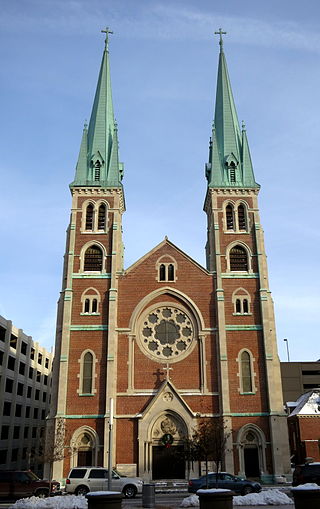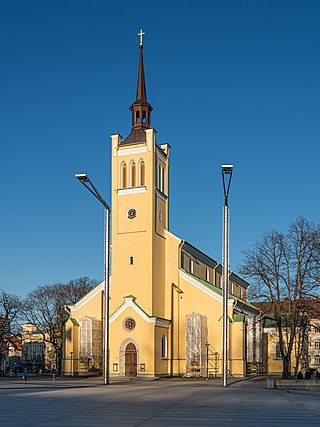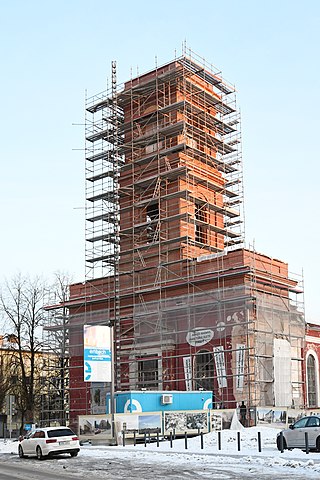
Saint Mary's Basilica is a Brick Gothic church adjacent to the Main Market Square in Kraków, Poland. Built in the 14th century, its foundations date back to the early 13th century and serve as one of the best examples of Polish Gothic architecture. Standing 80 m (262 ft) tall, it is particularly famous for its wooden altarpiece carved by Veit Stoss (Wit Stwosz). Some of its monumental polychrome murals were designed by Poland's leading history painter, Jan Matejko (1838–1893). In 1978 it became a UNESCO World Heritage Site alongside the Historic Centre of Kraków.

Sacred Heart Cathedral, located in Davenport, Iowa, United States, is a Catholic cathedral and a parish church in the Diocese of Davenport. The cathedral is located on a bluff overlooking the Mississippi River to the east of Downtown Davenport. It is listed on the National Register of Historic Places as part of the Sacred Heart Roman Catholic Cathedral Complex. This designation includes the church building, rectory, and the former convent, which was torn down in 2012. The cathedral is adjacent to the Cork Hill Historic District, also on the National Register. Its location on Cork Hill, a section of the city settled by Irish immigrants.

St. Olaf’s Church or St. Olav's Church in Tallinn, Estonia, is believed to have been built in the 12th century and to have been the centre for old Tallinn's Scandinavian community before Denmark conquered Tallinn in 1219. Its dedication relates to King Olaf II of Norway. The first known written records referring to the church date back to 1267. It was extensively rebuilt during the 14th century.

St. Nicholas Church is a medieval church building in Tallinn (Reval), Estonia. It was dedicated to Saint Nicholas, the patron of the fishermen and sailors. Originally built in the 13th century, it was partially destroyed in the Soviet bombing of Tallinn in World War II. The building itself has since been restored; however, as a church without its own congregation, it has not been used for regular religious activities since World War II. At present it houses the Niguliste Museum, a branch of the Art Museum of Estonia, focusing mainly on ecclesiastical art from the Middle Ages onward. It is also used as a concert hall.

St. Procopius Church is the parish church of the district of Žižkov in Prague, Czech Republic. Dedicated to the patron saint of Bohemia, Procopius of Sázava, the three-aisled Neo-Gothic church, located at Sladkovského Square on Seifertova Street, was designed by Bohemian architects Josef Mocker and František Mikš. Its steeple dominates the skyline of Žižkov.

St. Mary's Catholic Church, also known as St. Mary of the Visitation Church, is a parish church of the Diocese of Davenport which is located in Iowa City, Iowa, United States. The church building and rectory were listed together on the National Register of Historic Places in 1980. They were both included as contributing properties in the Jefferson Street Historic District in 2004. The parish's first rectory, which is now a private home, is also listed on the National Register as St. Mary's Rectory. It is located a few blocks to the east of the present church location at 610 E. Jefferson St.

St Martin's Cathedral is a cathedral in Slovakia. It is located in the town of Spišská Kapitula and is the cathedral church of the Spiš diocese.

The Church of St. Mark is the parish church of old Zagreb, Croatia, located in St. Mark's Square. It is one of the oldest architectural monuments in Zagreb.

Saint John the Evangelist Catholic Church is a Catholic parish of the Archdiocese of Indianapolis in Indianapolis, Indiana, United States. The parish's origins date to 1837, when it was first named Holy Cross parish. In 1850 it was renamed Saint John the Evangelist parish, and is the oldest Catholic parish in the city and in Marion County, Indiana. Considered the mother of the Catholic parishes in Indianapolis, it played an important role in development of the Catholic Church in the city. Saint John's Church served as the pro-cathedral of the diocese from 1878 until 1906; its rectory served as the bishop's residence and chancery from 1878 until 1892. In 1900 the church served as the site of first episcopal consecration held in Indianapolis.

St. John's Church is a large Lutheran parish church in Tallinn, Estonia. It is dedicated to Saint John the Evangelist, a disciple of Jesus Christ and author of the fourth Christian Gospel. Construction began in 1862, and the church was opened in 1867.

St. John's Church, Tartu is a Brick Gothic Lutheran church, one of the landmarks of the city of Tartu, Estonia. It is dedicated to John the Baptist.

Kihelkonna St. Michael's Church, sometimes simply Kihelkonna Church, is a medieval Lutheran church on Saaremaa island in western Estonia.

The St. Peter in Chains Church is a church in Neo-Gothic style with a rich Baroque interior located at the Market Square in Beringen, Belgium. It is the parish church of Beringen centre and the decanal church of the deanery of Beringen. The chancel, nave and transept are protected since 1949 and the neo-Gothic parts since 1993.

The Church of the Holy Apostles Peter and Paul in Bydgoszcz is located in Bydgoszcz, Poland, on Wolności Square. Patron saints are Saint Peter and Saint Paul. The church, richly decorated with polychrome has been realized in 1957 by Władysław Drapiewski from Pelplin and Leon Drapniewski of Poznań; it has been registered on the Pomeranian Heritage List on 5 October 1971.

The Immaculate Conception Church also known as the Catholic church in Tartu and more formally "Church of the Immaculate Conception of the Blessed Virgin Mary" is the name given to a religious building belonging to the Catholic Church, located in the city of Tartu, the second largest in Estonia.

The Cathedral Basilica of the Assumption of the Blessed Virgin Mary also called Białystok Cathedral is a Roman Catholic cathedral in the city of Bialystok in Poland. It was designed by architect Józef Pius Dziekoński. The three-nave church is 90 meters long and can accommodate 9,500 worshipers. The two towers reach 72.5 meters high. It is the main church of the Archdiocese of Bialystok and acquired the status of basílica in 1985 by decision of Pope John Paul II.

The Basilica of St. James is a Gothic church in Levoča, Prešovský kraj, Slovakia. Building began in the 14th century. It is a Catholic parish church, dedicated to James the Apostle.

St Mary's Church is a 19th century church of the Estonian Evangelical Lutheran Church located in Tartu, Estonia.

St Paul's Church is a 20th-century church of the Estonian Evangelical Lutheran Church located in Tartu, Estonia.

The Alexander Nevsky Church is an orthodox church in the Haapsalu old cemetery, Estonia. It was built to a design by Alexander Krasovsky in a typical Russian Revival style between 1896 and 1897, during the period when the country was part of the Russian Empire. It is dedicated to Saint Alexander Nevsky who in 1242 won the Battle of the Ice on Lake Peipus, in the territorial waters of present-day Estonia. The late Estonian Metropolitan, Cornelius (Jakobs), started his priestly ministry in the church.



























